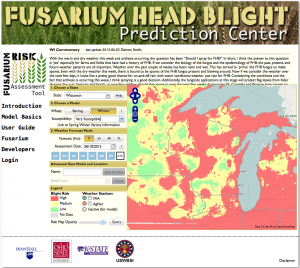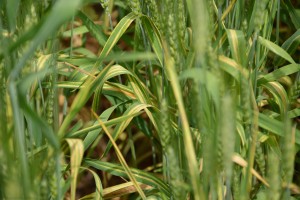Wisconsin Winter Wheat Disease Update – June 10
Damon Smith, Extension Field Crops Pathologist, Department of Plant Pathology, University of Wisconsin-Madison
Winter wheat in much of southern and central Wisconsin is now in active anthesis or past anthesis. Spraying for Fusarium head blight (FHB) is not recommended once wheat has progressed past 7 days after anthesis. Wheat from the east central to northeast is likely approaching or at anthesis. Spraying for FHB on winter wheat in these areas is recommended. Caramba and Prosaro have proven to be the best products for FHB control, however, timing of application is critical. These products must be applied at the beginning of anthesis with good efficacy achievable up to 5-7 days after the start of this growth stage. The FHB Prediction Center is forecasting moderate to severe FHB from Fond du Lac up through Door County for ‘very susceptible’ winter wheat varieties (Fig. 1). Wheat at the susceptible growth stage is at risk and spraying in these areas is recommended. Additionally, sprays at this time will also help manage foliar diseases such as rust that may move in and reduce yield during grain fill.
Brian Mueller, graduate student in my program, observed the first pustules of stripe rust on winter wheat in Wisconsin in 2015 (Fig. 2). These pustules were found in Sharon, WI in the UW wheat variety trial on June 4. This location is west of Janesville, near the Illinois border. Pustules were located in just one plot on a single variety during that first visit. Scouting was conducted again on June 10 in wheat not treated with fungicide next to the UW variety trial at this same location. Additional stripe rust infections were observed, however, severity remains low. I suspect stripe rust will continue to increase in this area and areas to the north. Cool wet weather is predicted for the next 5-7 days. This weather pattern will be conducive for stripe rust spread.
Cephalosporium stripe (Fig. 3) has also been identified in several fields around the state. Cephalosprorium stripe has been identified in winter wheat fields in Wisconsin over the last several years. Typically the disease has occurred in localized areas of the field, but in some cases it has been identified in wider areas depending on the varieties. No in-season management is available for Cephalospyrium stripe. However, noting which fields and locations in fields that have symptoms will help for future decisions about winter wheat management in those areas. Varieties with genetic resistance are available. Also longer rotations and better grassy-weed control can help reduce the severity of Cephalospyrium stripe. For more information about Cephalospyrium stripe CLICK HERE AND SCROLL DOWN TO THE CEPHALOSPORIUM STRIPE SECTION.
No other disease have been observed on winter wheat in Wisconsin this week. We will be scouting variety trials in the northeast later this week. We will continue to report any diseases we observe.





